Devil May Cry Updated Preview
That you want to know about Devil May Cry is a given. We provide you with information.
It's quite surprising to know that Devil May Cry began its developmental life as an installment in Capcom's Resident Evil series. Maddening velocity definitely isn't something that people have come to associate with the venerable survival-horror series, yet such is what Devil May Cry literally embodies. Considering this, it's no wonder that Shinji Mikami--the series creator and current executive producer--decided to dissociate the explosive piece of software from the franchise. After all, there's nothing that will alienate an established property's fan base than a wholesale flipping of the script.
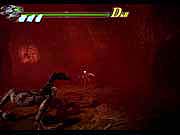
Mikami's decision may have been the most fortunate thing to happen to 3D console action games thus far in the 21st century, however. Had the game been shoehorned into the Raccoon City/Umbrella Corp. universe, it's unlikely that it would have turned out to be the willful, liberated game that it is today. Devil May Cry, simply put, moves in ways that modern games seem to have forgotten how, and its technical production is masterful. It really is dangerously close to establishing the precedent for 3D console action games.
It's definitely tempting and easy to lump the game in the survival-horror category: It shares sufficient superficial similarities with such games, and they're immediately apparent. Still, to call Devil May Cry an entry in the survival-horror subgenre--or, for that, even an extension of it--does it little justice. The game is more Strider than Silent Hill, and it gleefully demolishes most of the conventions associated with survival-horror. Ammo scarcity is a nonissue: Your guns have bottomless clips, and you're more than encouraged to unload them without heed. By the same token, you'll seldom be encouraged to avoid combat; the game encourages you to wildly cut and blast through the largest of hordes, and it even rewards you for doing so with panache. And given the glorious attention paid to the game's control mechanics, the minute-to-minute sword/gunplay is arguably the game's star.
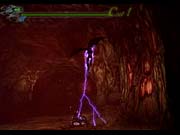
Costarring in the game is Dante the half-devil, perhaps the most hard-core character to ever grace a collection of code. Being something of a combination of Strider Hiryu and Alucard from Castlevania, Dante is the most dynamic character to be conceived in a long time. He's also the digital, interactive manifestation of rock 'n roll, but that's another story. The narrative wrapped around this mad character is as amusing as it is questionably conceived. Dante's the son of a heroic demon that lashed against the hordes of hell some time ago, in defense of humanity. Said infernal hordes, as it were, saw to it that Dante's lineage be eradicated one by one, prompting in the devil-man a desire for revenge.His job as a sort of supernatural private eye makes it easy for him to do this. At the game's outset, a mysterious woman pays a visit to Dante's run-down office space. Dante is caught mid-jam by this most blonde beauty, who seems to both know a bit about his devilish heritage and shares a resemblance to his mother. After some friendly horseplay (which involves the impaling of Dante by his own sword and the hurling of a motorcycle on him), the two decide to join forces, and they venture to a remote island, which the lord of hell plans to use a resurrection site.
In any event, Devil May Cry was recently released in Japan, and we've spent quite a bit of time exploring its fiery innards. Read on, and get a glimpse of what to expect when it drops Stateside.
ROCK THE HEAVEN!
However hard it is to believe after indulging in countless barrages of media, Devil May Cry's most powerful aspect has nothing to do with its presentation. It's the way Dante moves--and your magnificent level of control over how he does so--that leaves the most powerful impression. You're given full-on 3D control of Dante, and his responses are lightning-quick. Further, his flurry of attacks is similarly simple to execute, though the depth possible through combos is reminiscent of a fighting game's dynamics. Factor into this the wild fruit of the interplay between sword, fist, and firearm, and you have a sensation that only the interactive medium can truly provide.
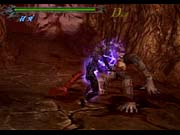
The control scheme works wondrously. You execute hand-to-hand attacks with the triangle button, and you fire your guns with either the square or circle. Jumps are achieved by means of the X button, a double dose of which is easily doable, provided you either propel yourself off a wall or have the appropriate power-up. You can also attack midair, as well as fire most of your guns. The R1 button is also much used: It lets you auto-aim and autoface your targets, as well as execute a number of defensive moves, when used in tandem with the jump button--rolls, flips, and the like. The L1, finally, serves as the "Devil Trigger," allowing you to summon forth Dante's devil form. His exact form depends on which of the melee weapons he's equipped with, though the results are unfailingly brutal.
Throughout the course of his quest, Dante will find a whole mess of weapons, both hand-to-hand and firearms. His sword antics have been well documented: He can execute a flurry of slashes, hike foes up in the air, only to follow up with any number of brutalities, and dash forward to impale any unfortunates in his path. Numerous changes have been effected, though, since we last played the game. Now, when attacking with the sword, a number of timing-based combos can be executed. The standard routine is a three-hit chain, though if you time the third slash correctly, you can execute a brutal five-hit combo. Time the third slash a little differently, and you enact a series of quick thrusts, the number of which is only limited by the quickness at which you pound the triangle button. There are also a whole bunch of special attacks that you can "purchase," which further extend the capabilities of your lightning sword: the aforementioned dash attack, a sword-throw move that's particularly nasty, though often ineffective.
| Silent Bomber | ||||
| | ||||
| ||||
Eventually, however, you'll find a set of gauntlets that allow Dante to get a bit more personal. These will enable the martial arts moves you've seen in the more recent movies. Just like the sword (named Alastor) is imbued with a lighting characteristic, the gauntlets (named Ifrit) are all fire. Their basic mode of assault is a five-hit combo, every blow of which can be charged for particularly explosive results. The jump attack that the gauntlets provide is swift and nasty: Dante lunges toward his enemies at a steep angle, like a human dart, flaming feet first. Acquire the appropriate power-ups, and you'll be able to shoot fireballs from your fists, execute lethal forward-flying kicks, and even immolate yourself, damaging all of those around you.
Hand-to-hand attacks are only half the story, though. Dante has access to a whole bunch of firearms, which, when used in tandem with melee attacks, truly define the Devil May Cry experience. Ebony and Ivory, the twin pistols that you're armed with have at the outset, are essentially machine guns. The rate at which they unload lead is dizzying and, when shot in the air, slow your descent enough to layer on a level of carnage that is gleefully gratuitous. The shotgun is more slow going, though it's far more damaging. The grenade launcher is even more devastating, though it brings with it the disadvantage of being unfireable from the air. You'll also eventually find a hell-powered "nightmare" gun that fires rebounding shells, and a needle-launcher that's useable underwater. We wouldn't want to ruin the particulars for you, however.
Devil's miscellany
Alongside the game's minute-to-minute madness is an economy whose influence is felt, literally, after every single shot is fired and every blow is struck. It works like this: Every enemy you kill will drop "red orbs," which serve as a sort of devil cash. You use these to buy items and special moves at the beginning of each mission or at preset terminals spread throughout the game's environments. The value of the orbs dropped by the enemies, though, depends on how exactly you dispatch them. To determine this, the game uses a grading system that rates each of your engagements. Essentially, after every few attacks, a grade will appear onscreen, which ranges from "dull" all the way to "cool," "bravo," "awesome," and "stylish." In theory, the diversity of your moves determines exactly how you'll be rated. In practice, though, we've found that if your stream of attacks is steady enough, you'll eventually reach awesome. Stylish, however, usually seems to require that you execute ultradamaging attacks in devil mode.
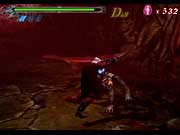
Luckily, you'll find that the game encourages such metamorphoses. Your devil meter rests right above your life gauge, and it gradually fills--very quickly--as you fight. The devil trigger is by no means something that you'll use sparingly--quite the contrary. During most long engagements, you'll find that your devil meter will empty and refill a number of times. Doing so is a vital tactic to survival, especially during the game's crazy boss battles; while in devil mode, your life bar will gradually regenerate, which, given the brutal cap on the number of healing items you can carry, means that it will often be your sole manner to replenish life. The devil trigger's most prominent effects, however, are the speed and power boosts they grant. Apart from making Dante crackle with demon energy and turning his skin to charred chitin, it also makes him much faster and stronger. Devil mode is also where you can execute your most powerful attacks. Depending on whether you're wielding the sword of the gauntlets, you have access to one überattack (which you must, of course, pay for): Air Raid, for the sword--which you've all undoubtedly seen--sprouts wings and hurls lighting bolts, and Inferno, for the gauntlets, sets your immediate environs aflame, basically destroying everything in your vicinity.
A host of mundane items are also available for purchase or, less often, scattered throughout the world. They serve all kinds of effects: healing, devil-meter replenishment, the impartment of temporary invulnerability, and the like. Some have permanent effects--like the blue orbs that increase your life meter. Still others have immediate effects--like the vials of holy water that annihilate everything onscreen.
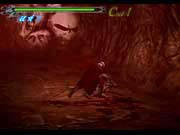
The game, though, encourages you to rely on the tools at your immediate disposal; namely, your hands, swords, guns, and demon powers. The items really do play an auxiliary role in the proceedings, and that they're buried behind two layers of interface makes this fact hit home. Often, you'll even forget that you have this small arsenal at your disposal. This may be deliberate or the result of sloppy interface design. In any case, it results in a sense of maddening immediacy that is altogether pleasant.
Aesthetics
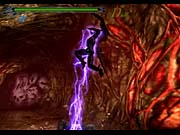
Once you get over the shininess of the game's visual production, its flighty visual style will grip you. There's no denying that there's some macabre stuff dwelling in this world--what with the animated marionette butchers; carnivorous lizardmen; scissor-wielding bull-headed wraiths; and such. But given just how gratuitously macabre the game's imagery is, it often comes off as slightly whimsical, especially when it's coupled with the campy tone of the game's story as presented by its cutscenes. The effect is quite refreshing, overall, even if it perhaps wasn't intended--Devil May Cry doesn't appear to take itself too seriously, most of the time. Other times, though, it ladles on the creeps with an earnestness that rivals a power-metal ballad. Largely, the game feels like it's the product of Japan's consumption--and subsequent regurgitation--of heavy metal aesthetics and imagery. As such, however, it's marvelously realized. Mikami stated that he wanted the game to embody "cool," and as he was wearing a leather jacket and shades while saying this, we can only assume that he meant "cool" in the Gene Simmons sense.
| Do you like the devil? | ||||
| | ||||
| ||||
Clearly, Devil May Cry is in a class by itself, and we don't expect any of this to change with its stateside release. The game features 23 missions, several levels of varying difficulty, and a couple of features that are unlocked upon clearing. It also features a level of immediate, mechanical depth absent from console action games for a very long time--truly a twitch gamer's game, though one with all the production-related niceties that have come to define much of modern gaming. Capcom definitely came out of the blue with this one, relatively speaking, and by all accounts, it's going to be the start of big things. We'll have a full review for you, needless to say, when the game hits North America next month. Till then, look at screenshots, watch movies, and play that Code Veronica X demo with the knowledge that you ain't seen nothing yet. We've but one request for Capcom: Please, make a next-gen Strider game with this technology.
Got a news tip or want to contact us directly? Email news@gamespot.com
Join the conversation